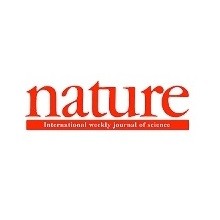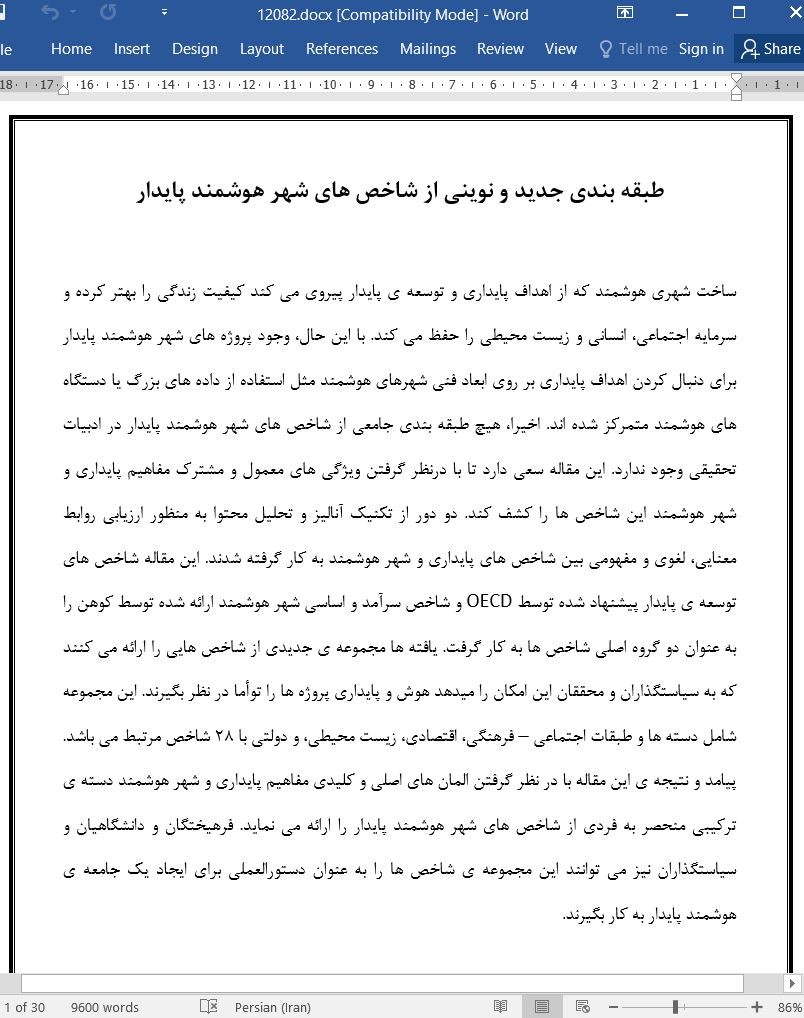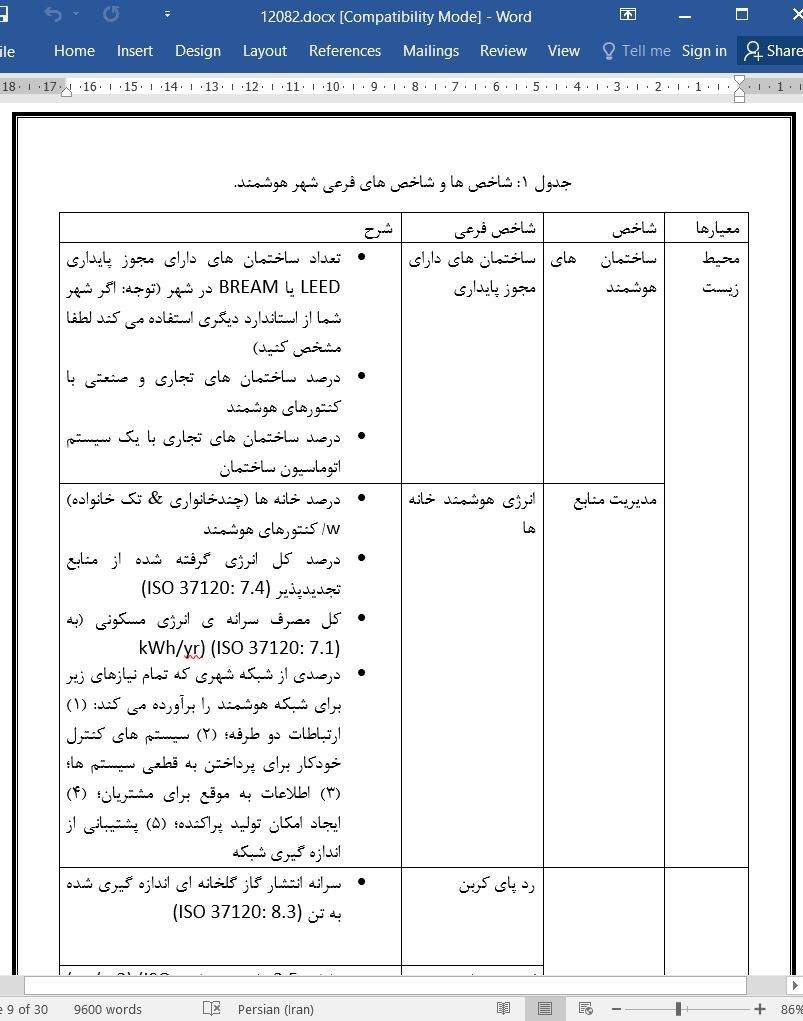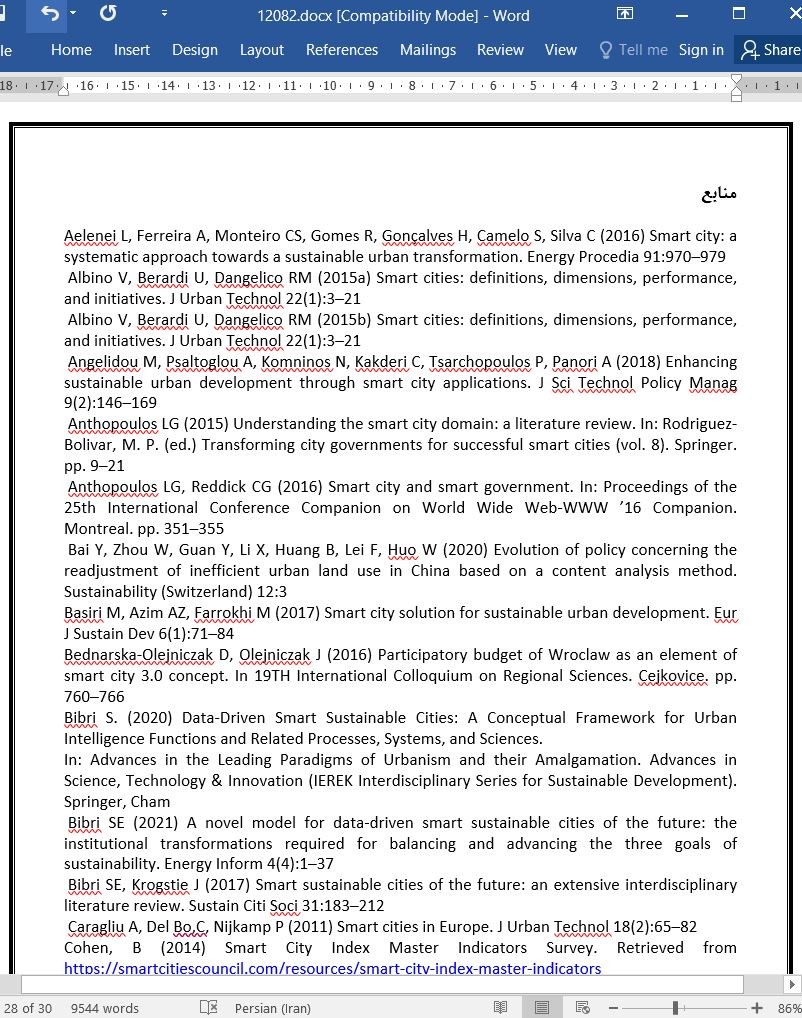
طبقه بندی جدید و نوینی از شاخص های شهر هوشمند پایدار
ساخت شهری هوشمند که از اهداف پایداری و توسعه ی پایدار پیروی می کند کیفیت زندگی را بهتر کرده و سرمایه اجتماعی، انسانی و زیست محیطی را حفظ می کند. با این حال، وجود پروژه های شهر هوشمند پایدار برای دنبال کردن اهداف پایداری بر روی ابعاد فنی شهرهای هوشمند مثل استفاده از داده های بزرگ یا دستگاه های هوشمند متمرکز شده اند. اخیرا، هیچ طبقه بندی جامعی از شاخص های شهر هوشمند پایدار در ادبیات تحقیقی وجود ندارد. این مقاله سعی دارد تا با درنظر گرفتن ویژگی های معمول و مشترک مفاهیم پایداری و شهر هوشمند این شاخص ها را کشف کند. دو دور از تکنیک آنالیز و تحلیل محتوا به منظور ارزیابی روابط معنایی، لغوی و مفهومی بین شاخص های پایداری و شهر هوشمند به کار گرفته شدند. این مقاله شاخص های توسعه ی پایدار پیشنهاد شده توسط OECD و شاخص سرآمد و اساسی شهر هوشمند ارائه شده توسط کوهن را به عنوان دو گروه اصلی شاخص ها به کار گرفت. یافته ها مجموعه ی جدیدی از شاخص هایی را ارائه می کنند که به سیاستگذاران و محققان این امکان را میدهد هوش و پایداری پروژه ها را توأما در نظر بگیرند. این مجموعه شامل دسته ها و طبقات اجتماعی – فرهنگی، اقتصادی، زیست محیطی، و دولتی با 28 شاخص مرتبط می باشد. پیامد و نتیجه ی این مقاله با در نظر گرفتن المان های اصلی و کلیدی مفاهیم پایداری و شهر هوشمند دسته ی ترکیبی منحصر به فردی از شاخص های شهر هوشمند پایدار را ارائه می نماید. فرهیختگان و دانشگاهیان و سیاستگذاران نیز می توانند این مجموعه ی شاخص ها را به عنوان دستورالعملی برای ایجاد یک جامعه ی هوشمند پایدار به کار بگیرند.
مقدمه
نوآوری ها و ابتکارات شهرهای هوشمند ابزار جدیدی را برای ارتقای شهرداری ها در اختیار مقامات مسئول و سیاستگذاران قرار می دهند. این مفهوم آینده ی منازل شهری را شکل می دهد (لا و لینچ، 2019). از نقطه نظر تاریخی، مفهوم شهر هوشمند بر روی فناوری، وسایل هوشمند، و زیرساخت های شهری متمرکز بود (وانولو، 2014). اخیرا، شهرهای متعددی مفهوم شهر هوشمند را بسط داده اند تا ابعاد اجتماعی اقتصادی را در آن بگنجانند (شیچیاخ و همکاران، 2016). ترنچر (2019) مناسب ترین توصیف مفهوم که برای پروژه های شهری اعمال شده را ارائه می کند: "شهرهای هوشمند مردم را در اولویت قرار می دهند و فناوری را به عنوان ابزاری کاملا در خدمت شهروندان و برای استفاده ی آنها معرفی می کند" (p.118). این تکامل مفهوم شهر هوشمند به فراتر از آنچه قبلا بود می برد ضمن اینکه صرفا بر روی بعد فنی آن تمرکز می کند و تأثیرات بالقوه ای که روی مطالعات و پروژه های شهری دارد را بسط می دهد.
نتیجه گیری
شهر هوشمند یک مفهوم توسعه ی شهریست که از سوی محققان و مدیران پروژه ها برای پرداختن به امور شهری از طریق درنظر گرفتن شش المان و عنصر اصلی، اعم از جامعه، اقتصاد، مردم، زندگی و معیشت، محیط زیست، حمل و نقل و ترابری، و دولت و همچنین شاخص های مختلف به کار گرفته شده است. از سوی دیگر، پایداری رویکردی است که به صورت عامل کلیدی و اصلی برای حفاظت از منابع برای نسل های فعلی و بعدی به هنگام اجرای پروژه های منطقه ای، شهری، یا روستایی در نظر گرفته می شود. خلق یک شهر هوشمند پایدار اخیرا هدف اصلی چندین مطالعه ی دانشگاهی و دولتی بوده است. هر دو مفهوم توانایی های خود در جهت کم اثر کردن چنین مسائلی را ثابت کرده اند. لذا، به کار بردن طرح های ابتکاری و نوآوری های هوشمند به علاوه ی پایدار ابزار قدرتمندی را برای کاهش چالش های شهری ارائه خواهد کرد.
Building a smart city that follows sustainability goals enhances the quality of life and preserves environmental, human, and social capital. Yet, existing smart sustainable city projects have concentrated on the technological dimensions of smart cities such as using big data or smart devices to follow sustainability goals. Currently, there is no comprehensive category of smart sustainable city indicators in the literature. This paper aims to discover these indicators by considering the common features of sustainability and smart city concepts. Two rounds of the content analysis technique were employed to investigate semantic, lexical, and conceptual relationships between smart city and sustainability indicators. This paper employed the Sustainable Development Indicators suggested by OECD and the Smart City Index Master by Cohen as the two main groups of indicators. The findings offer a novel set of indicators that enables policymakers and researchers to consider the smartness and sustainability of their projects simultaneously. This includes socio-cultural, economic, environmental, and governance categories with 28 associated indicators. The outcome of this paper offers a unique combined category of smart sustainable city indicators by considering the key elements of sustainability and smart city concepts. Academics and policymakers can also employ this set of indicators as a guideline to build a smart sustainable community.
Introduction
Smart cities initiatives offer city authorities and policymakers a new tool for improving municipalities. This concept will shape the future of urban habitation (Law and Lynch, 2019). Historically, the smart city concept focused on technology1 , smart devices, and urban infrastructures (Vanolo, 2014). More recently, however, several cities have expanded the concept to include socio-economic dimensions (Shichiyakh et al., 2016). Trencher (2019) provides the most relevant description of the concept applied to urban projects: “smart cities put people first and stresses technology as a tool to use predominantly in service of citizens” (p. 118). This evolution moves the smart city concept beyond focusing solely on its technological dimension and expands its potential impacts on urban studies and projects.
Conclusion
Smart city is an urban development concept that has been employed by researchers and project managers to address urban affairs by considering six major elements, including society, economy, people, living, environment, transportation, and government as well as various indicators. On the other hand, sustainability is an approach that is construed as a key factor to protect resources for current and future generations while implementing regional, urban, or rural projects. Creating a smart sustainable city has been recently the main objective of several academic and government studies. Both concepts have proven their abilities to mitigate such issues. Thus, exploiting smart plus sustainable initiatives will offer a powerful tool to alleviate urban challenges.
مقدمه
شهرهای هوشمند و پایداری
شیوه و روش کار
نتایج و بحث
نتیجه گیری
منابع
Introduction
Smart cities and sustainability
Methodology
Results and discussion
Conclusion
References
- اصل مقاله انگلیسی با فرمت ورد (word) با قابلیت ویرایش
- ترجمه فارسی مقاله با فرمت ورد (word) با قابلیت ویرایش، بدون آرم سایت ای ترجمه
- ترجمه فارسی مقاله با فرمت pdf، بدون آرم سایت ای ترجمه



